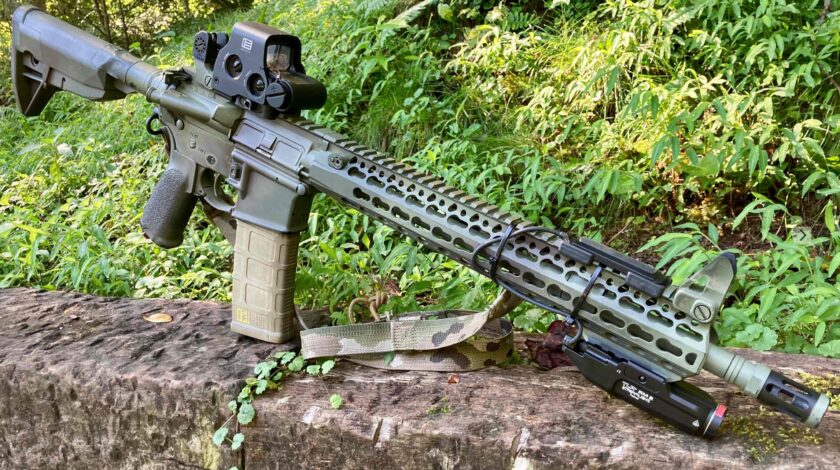In my last post on the defensive AR-15 I talked about sighting options for the defensive AR. Today I am going to talk about the only other accessories you truly need on a defensive AR. This is just my opinion and reflects my experience with the platform and my personal preferences and biases, so they may differ from yours. Also, I know this ground has been covered, but I haven’t had my say yet, so here it is.
This article contains affiliate links.
Saved Rounds
Oops, not so fast – I have a couple saved rounds from last time. After the last article published I was asked why I didn’t recommend fixed, low-power optics like the ACOG. If one person asked others probably had the question, so I’m going to answer it.
To be honest, I didn’t even think of optics like the ACOG (I know it’s not the only one but it’s representative of a class of optic, so I’ll use it as the example here). Again, these articles are largely the result of my own personal experience and personal bias. I was issued ACOGs – along with other optics – in the military. I had a choice of what optic I placed on what rifle. I carried an ACOG a little bit in Iraq but quickly switched to, and stayed with, the EOTech.
I don’t like the fixed, 4x magnification of the ACOG specifically, especially on a defensive carbine. Now, my definition of “defensive” is probably a bit more expansive than most. At it’s core it still encompasses defending your home from armed intruders who are inside your home, however. This requires the ability to see your sights and employ the rifle – as a primary task – at distances of zero to maybe 10 yards, and do so extremely quickly. You may be thinking, “but you could do that with anything. You could do that with no sights!”
Sure, if any hit, anywhere is all you’re after you probably could do it with no sights at all. I have absolutely no doubt that some of you could hit a silhouette blindfolded with nothing more than a decent kinesthetic index. But if you need to guarantee a hit on a relatively small area – because the individual has sought cover, is wearing armor, is in proximity to your family members, etc. – your sighting arrangement and your ability to see it will probably become pretty important. As will your ability to deploy that sight at indoor ranges (i.e. your ability to understand barrel/sight relation and apply appropriate holdovers)(which you’re only going to get really adept at applying – under stress – with a large number of repetitions) and with indoor lighting which ranges widely room-to-room and hour-to-hour from fully lit to fully dark. One other twist is that you’re probably going to want to do that stuff really, really quickly.
Will the ACOG work in this environment? Sure, and it has worked well for plenty of dudes in IZ and AF. Is it ideal in this environment? My feelings are: “no. It’s a great compromise between indoor and outdoor capabilities but it’s not ideal for indoors.” But that’s your choice. Again, a (if not the) primary purpose of the defensive carbine is defense inside the home. The ACOG is a fantastic tool for combat operations where even if your job is in-room CQB, you still have to transit a lot of miles through the great outdoors just to get to and from your target, so having a strong outdoors capability is pretty important. It is probably significantly less important to the average civilian.
The second reason I don’t like low, fixed-power optics like the ACOG is they are often pretty expensive for what you get. Legit ACOGs run around $1,000. At that price-point you’re almost into LPVO territory. If I were going to drop that kind of money on a 4x scope… Well, I’d keep saving and get something that is a little more flexible like an LPVO (personally, I really like the overlooked ELCAN Spectre DR 1-4. I was part of the military T&E team fielded to test the FN SCAR, which is where I got introduced to the 1x-4x Spectre. With the throw of a lever you go from 1x magnification to 4x magnification. The sight has a simple red dot and an illuminated reticle with a 5.56 (or 7.62) bullet drop compensator. The “DR” in the name – Dual Role – is apt, as this optic can easily transition from intermediate-distance street fighting to indoors and back to longer distance with the throw of a lever. Unfortunately at $1,800 this is a little outside of my budget at the moment. One day, maybe.).
I also neglected to mention a couple of other things, like offset sights, or backup mini-red dot optics and offset sights. There is absolutely merit to these tools. Even the ACOG is available with a mini-red dot or oversized iron sights mounted atop it. Offset mounts are available that place the red dot 45 degrees to the rifle, allowing the user instant access by canting the rifle. These are viable options. I don’t have a ton bad to say about them. If you want them, go for it, but I don’t think they’re necessary on a typical defensive carbine, and they do add a bit of bulk and weight.
Holy shit – I guess I still had way more to say about optics, even after I thought I was finished last week, and even though I am definitely not an “optics guy” (for instance I couldn’t even begin to tell you the difference between first- and second focal plane…). Keep in mind, these are just my thoughts. If you like the ACOG (or whatever) go with it! You’ll be just fine as long as you train with it well and regularly. Now let’s get into what this article is really about: the other stuff you should put on your AR.
Lights
After sights, I think the single most important feature on your defensive carbine is a white light. You can’t hit what you can’t see, and you absolutely SHOULD NOT shoot what you can’t identify. A weapon-mounted light is a crucially important accessory for your defensive carbine.
I have worked with a number of lights in the past twenty years. Some of them have been fantastic, and some of them have been crap. The light I would recommend for most users is the Streamlight TLR-1 HL with long-gun pressure pad. I have used this on several carbines and will absolutely vouch for it. While not the smallest, brightest, lightest, or sexiest light out there, at $160 it’s an outstanding value for a workhorse of a light. The other Streamlight I can recommend is the brand new TRL RM-2, a purpose-built carbine light that I’m running on my gun. I have a full review of this light coming, so stay tuned.
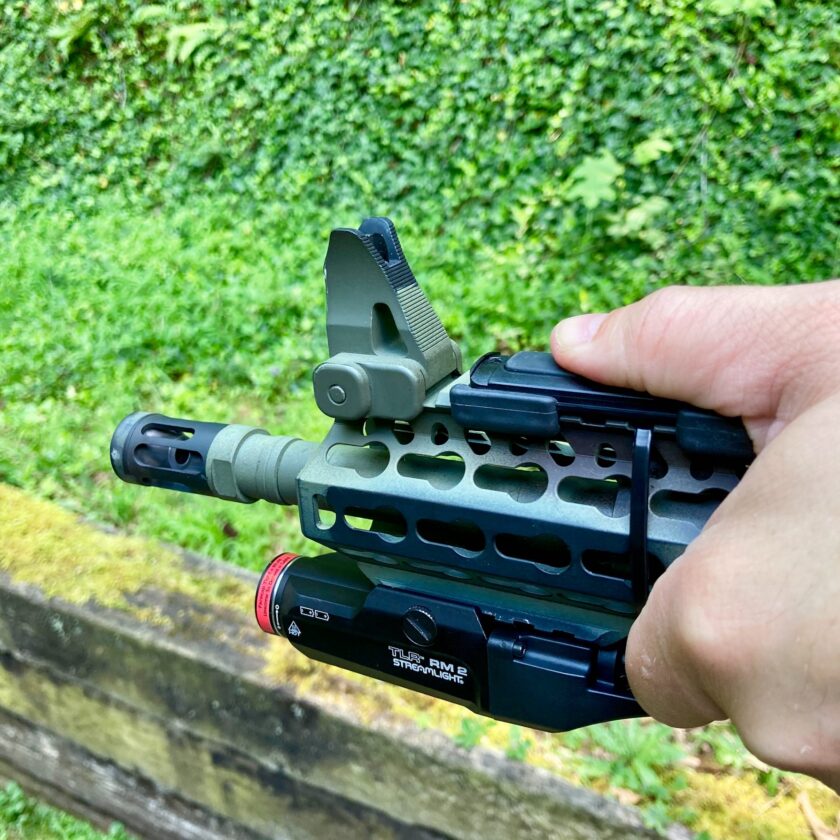
I really like a light with a pressure pad for several reasons. First, thumbing a tail switch requires a slight alteration of my grasp. Admittedly this is not the biggest deal, but it’s also not ideal. If properly placed the pressure pad eliminates this problem. I also like that a pressure pad makes the light easy to use when firing from the support side. The odds of me needing to shoot weak-sided are pretty low, but I do practice that way.
There are some downsides to pressure pads, though. They’re big, making “white light NDs” (negligent discharges) more likely. They’re also more likely to get damaged – I’ve seen them get completely eaten up by friction against a FAST rope. And they introduce more complexity – wires, connections, etc. – into the system. Overall they aren’t bad as long as you’re aware of them. I’ve used them on work rifles and I’d do it again in a heartbeat. Let’s look at some non-pressure pad lights.
I can also personally speak to the Surefire M600 Scout which I’ve used on work rifles. This is another outstanding light. It’s 500 lumens brighter than the TLR-1 HL, but it will cost you $100 more…and that doesn’t include a pressure switch. Being constructed of aluminum, and being a tad lower profile, I do think it’s probably a little more rugged than the TLR-1. I admit that I sort of lust after the OWL from Cloud Defense. Unfortunately, I can’t personally vouch for it, nor can I really justify its price…and I think you’ll be just as well served by a less expensive option.
I also want to briefly address the one light I would NOT recommend: the InForce WML family. I own two of these that I purchased out-of-pocket because I thought they might be a cost-effective WML option. I really wanted them to work. The problem with both is that they are unreliable. Sometimes the light will flicker as if some connection isn’t solid. Sometimes this happens only after using the light for a bit but a change of batteries won’t correct it, ruling out power failure. Sometimes the light will only flicker. The unit seems extremely sensitive to everything being tightened completely, and seems to have an issue with things loosening up. At $120/each there isn’t much savings to be had over a Streamlight, so I wouldn’t waste my money on these…but now I have some loaner lights!
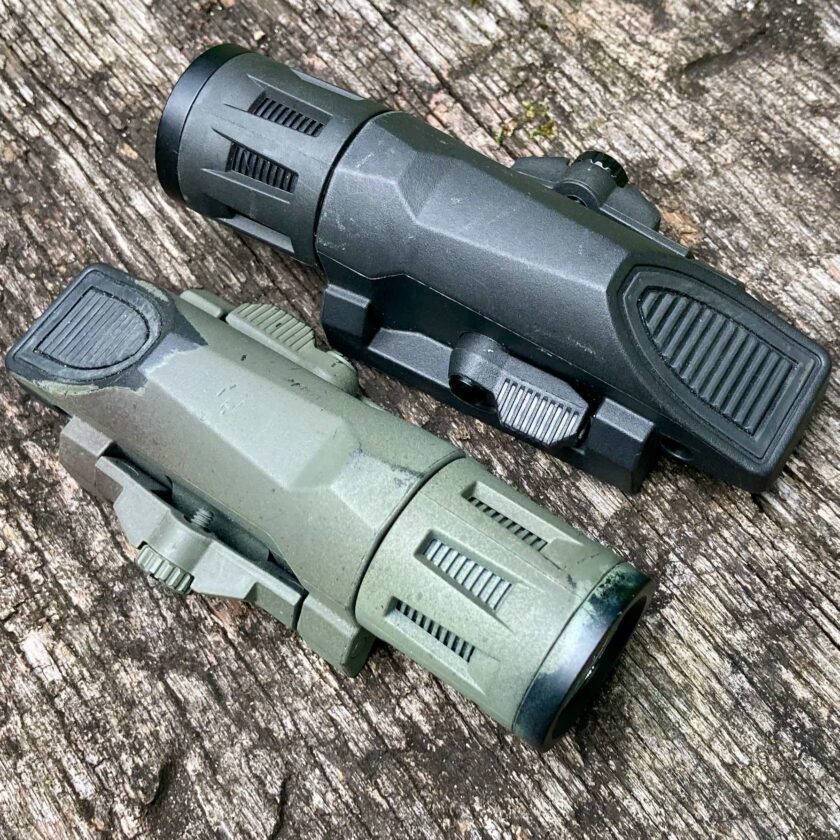
I recommend mounting the light as far out on your rail as possible. If your light gets obstructed by your support hand, it’s not going to be much use. If possible, mount the light in such a way that you can actuate it with either hand. This is pretty easy to do with a pressure pad (just put the pressure pad where you want it) but harder to do with most tail-switch lights. I personally like mounting the light under the rail (assuming it has a pressure pad) rather than on one side or the other, which makes the profile of the gun a bit wider, and puts the light right behind door jambs and other vertical concealment you may be using. Not a huge deal, but if I could have my ‘druthers I’d mount the light under the rail.
Sling
Now, the only thing I think a defensive carbine actually needs besides and optic, some irons (be they bare-bones backups or a halfway decent set of co-witnessed sights), and a light is a sling. Sights, light, sling – that’s really about it. Why do I think a sling is important for a defensive carbine? A couple reasons.
First, a sling lets you put the rifle “down” without losing control of it. You can open doors, pick up your child, control your dog, move stuff out of the way, and probably do a ton of other stuff that I simply can’t imagine right now, without having to prop your rifle up in the corner or lay it on the floor. If you set the rifle down, not only is it out of your hands, it is also potentially available to anyone else in the space. If there is a potential to need the rifle, I sure as shit don’t want to be setting it down and turning my attention away from it.
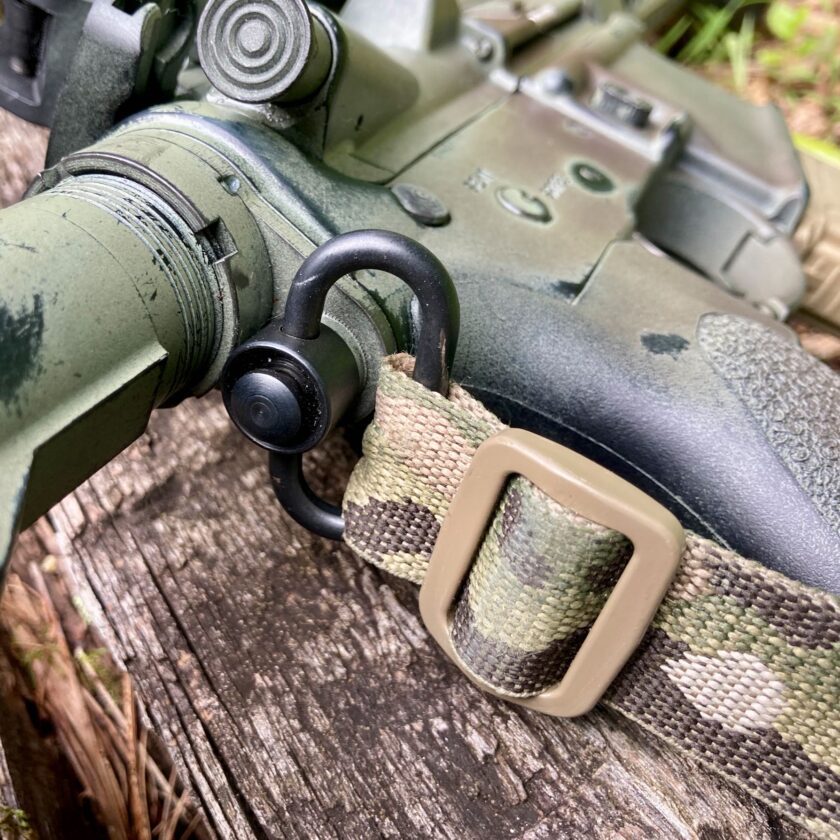
Second – and in my mind this is absolutely the MOST important reason to have a sling: there is retention of the rifle to worry about. Let’s assume I wake up, grab my carbine, and walk out my bedroom door. In the highly unlikely event that someone is in my house before I’ve woken up and gotten out of bed (and assuming my GSD hasn’t run them off, cornered them, or is in the process of biting them [yes, she does have some bite training, though admittedly not in a while, so I’m not counting on her for much more than early warning] – or even if she has) they may well end up in close proximity to me. If they get their hands on my carbine and I don’t have a sling, now it’s my strength and skill against the other person’s.
My strength and skill are both pretty good. My strength against someone who is high on meth, or desperately needs to score before they get dopesick? What if there are two of them? And what if they surprise me? What if they get hands on me while I have one hand off the gun to push a bar stool out of the way? Are you absolutely confident you could defend your gun in all those situations? If not, you should probably at least consider a sling. If I have a sling on the gun, the odds of it coming off my body are very, very low. A sling also means I can choose to just let the rifle go and switch to a secondary – a pistol, knife, OC, or even just hands depending on the situation and what I have available to me – to defend the rifle. Or it means I can keep rolling with the dude but either way unless he cuts the sling or finds the QD button, he ain’t getting my rifle. The point is I have more options than, “try to hang on with both hand, regardless of the ride he takes you on!”
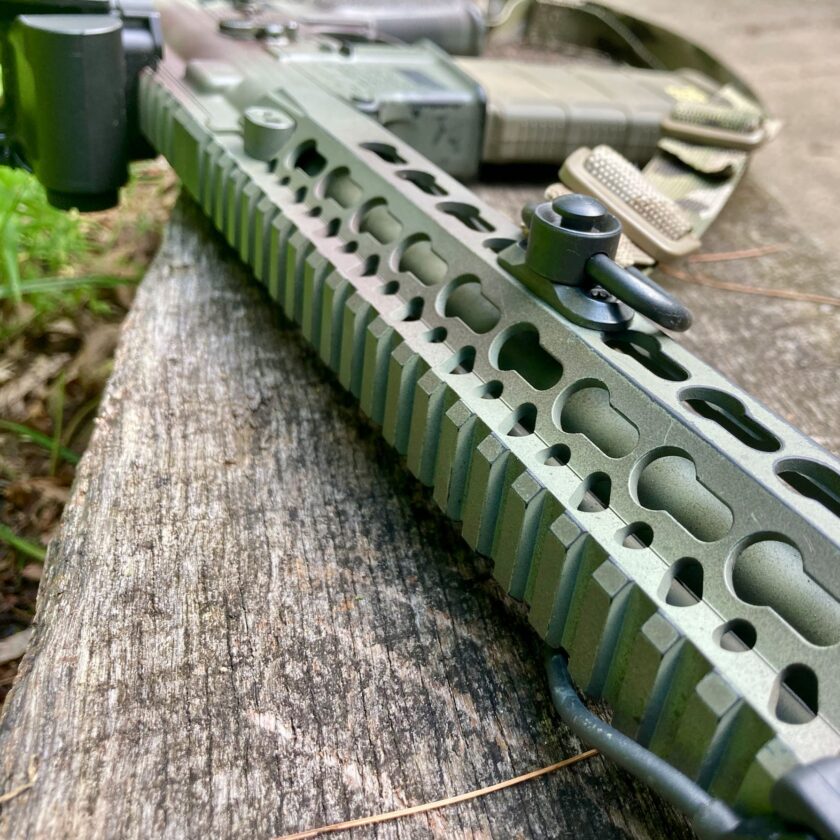
Finally, there’s the issue of the transition. Now, I think needing to transition from primary to secondary in a home defense scenario is about as likely as being a shark attack victim in the Snake River…but also admit those odds aren’t zero. Obviously that only applies if you have a handgun on you, so take it for what it’s worth and as it applies to you and your situation. In a normal home defense setting I wouldn’t worry too much about making sure you get your pistol belt on so you can transition before getting your long gun in your hands, so again, take it for what it’s worth.
There are single-point, two-point, and three-point slings out there. There are dozens of articles debating the pros and cons of each (I was going to link to some but there are literally dozens; just search “single point vs two point” and let autofill do the rest). I’m not going to rehash all the pros and cons, but I will give you a very quick down and dirty.
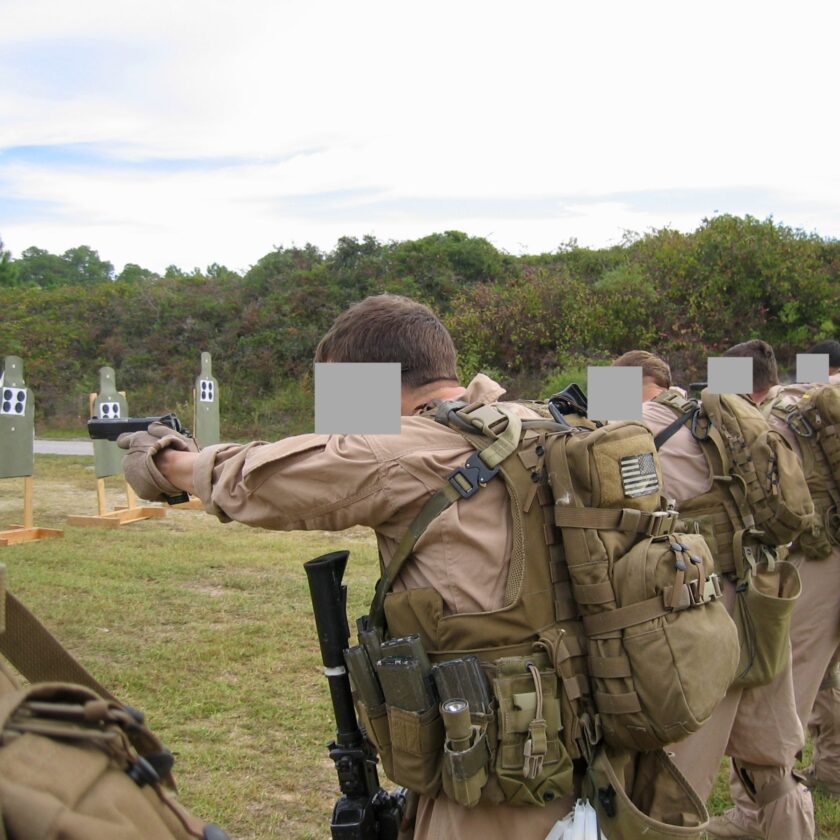
I think at this point very few people are making/selling three-point slings. We can rule that one out easily as complicated and cumbersome. The single point is fast but it doesn’t hold the gun very securely. If you let the gun go to transition, climb a ladder, put your hands on someone, whatever, the rifle is just dangling there cracking you in the knees…or worse. A single point, fixed at the rear of the receiver, is what I used for almost all of my time in the military. Again, it is fast, but I strongly prefer a two-point sling like the VTAC sling. I have VTAC slings on both my carbine and my shotgun.
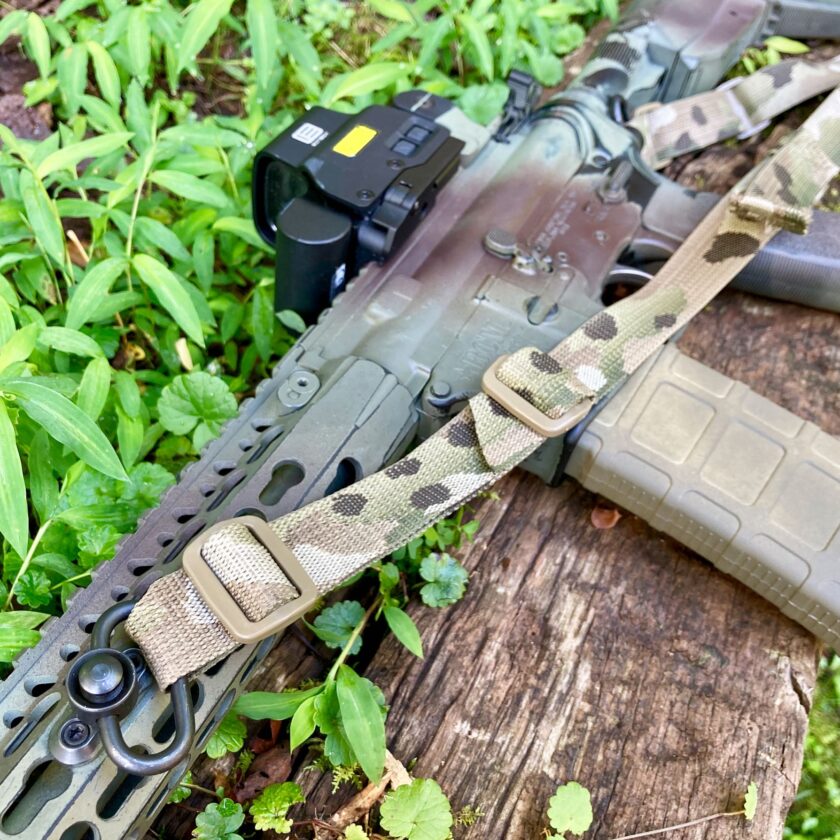
Kyle Lamb’s VTAC sling is sort of the original and – in my opinion – the best two-point sling, though I have used the Blue Force Gear Vickers sling, too. It can be looped over the head and one shoulder and tightened down to keep the gun close to the body. This is a very secure way to put the rifle out of the way to free up both hands. It can quickly be loosened up to allow you to shoot from this setup, too. If I feel like I’m really going to be shooting I generally drape the sling over my neck only, giving me maximum range of motion of the gun, but allowing me to drop the rifle if should I need to transition.
I have my sling connected via quick-detach swivels. I have one mount added (Keymod version) to my rail about halfway up the handguard. The other is a backplate on the back of the receiver which I’m almost 100% certain came on my gun from the factory. In my opinion this is about ideal placement to allow the sling full range of motion from loosened up enough to shoot effectively, to tightened down enough to secure it.
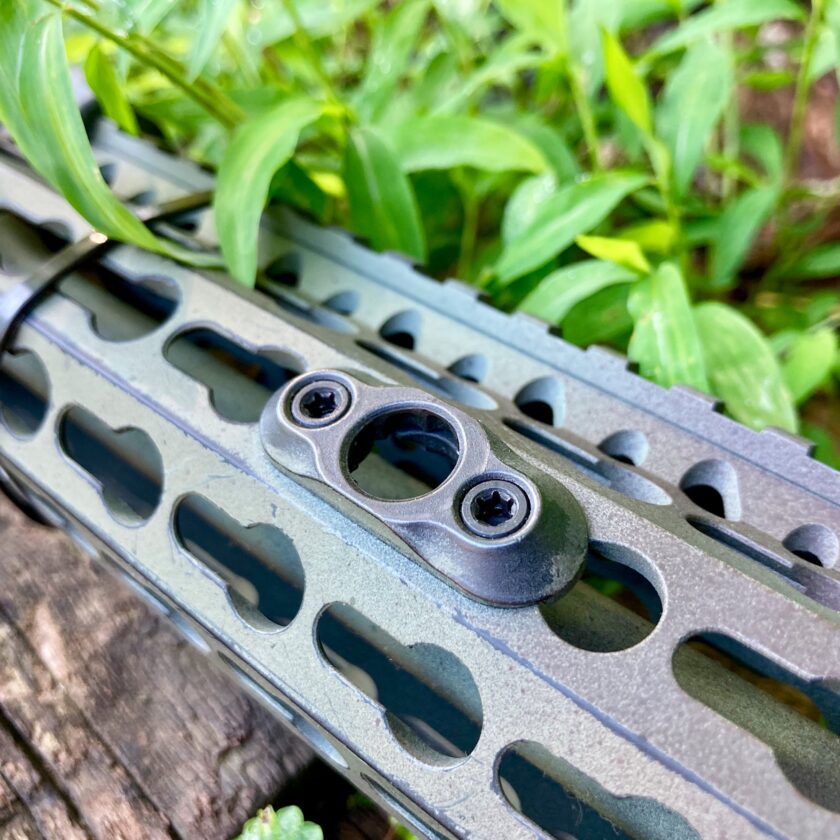
Closing Thoughts
So why not other stuff? There is a plethora of other stuff from foregrips to DBALs that you could put on your gun. Am I against them? No, not at all! I’m all for (I am about to sound like an old person trying to sound like a young person) “you doing you.” If you think you need that stuff, can afford it without borrowing money to pay for it, and can be effective with it, go for it! There are also really specialized applications – nighttime hunting or competition for instance – that would let you maximize some specialized gear, but we’re talking about a basic, defensive carbine. Give me a solid rifle with decent sights, a light, and a sling, and I’m a happy camper.
I’m going to talk more about the AR soon; less about what to put on it, and more about what to look for in the rifle itself, so stay tuned.
